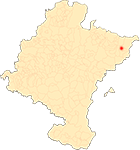Route through the Roncal altarpieces
By Ricardo Fernández Gracia
Main altarpiece of the Shrine of Our Lady of Fair Love of the Virgin of Zuberoa
In mid-June 1672, the mayor, jurors and neighbours of Garde requested licence from the ecclesiastical authority to remedy the state of ruin of the Shrine of Our Lady of Fair Love of the Virgin of Zuberoa. A French stonemason, Juan de San Martín, reported that he was of the opinion that the building had to be raised again, from its foundations, with new materials, as the old stone was only good for the shepherds' ditches. The abbot of Garde expressed the same opinion. Masters from different places attended the auction of the works, which were auctioned off to the master José Fernández, architect of Uncastillo. The valuation of the altarpiece was carried out in March 1700, although it was practically finished in 1680. In 1702, the aforementioned José Fernández declared that he had collected 2,756 reales. Among the alms for the works was the bequest of a son of Garde, Don Felipe de Atocha y Maisterra (1612-1667), a shipowner and sailor, in gratitude to the Virgin of Zuberoa, who had saved him from danger, which was graphically shown by a ship's mooring and a cannonball preserved in the sanctuary for centuries. This son of Garde had addressed several memorials to the king on the advisability of working wool in the peninsula and a very curious one, in 1648, in which he compared the poverty and depopulation of Spain with that of the rest of the world, advising on how to remedy it. Don Felipe de Atocha founded a chaplaincy and left money to be distributed in the Roncal valley and to support a school.
Exceptionally, the conditions of the works at Shrine of Our Lady of Fair Love included the work on the altarpiece and two collaterals. The altarpiece would have Solomonic columns and would be built in a year and a half from the two years in which it was estimated that the building would be constructed. The chronology of the altarpiece is therefore after 1675.
The gilding of the piece was carried out, as in the case of the main altarpiece of the parish church, by the master resident in the town, Joaquín Elizondo. The licence was obtained in 1704 and the cost was 200 ducats, which the artist received in 1717.
With a straight floor plan, it covers the entire chancel and is organised into three aisles articulated by grape salomónicas. In the main compartment, there are some salomónicas with helicoidal grooves running along the shaft, which are extremely rare in the region. But what is truly exceptional in these lands is the use of canvases in all its compartments. One of them is the work of Vicente Berdusán, with a workshop in the capital of La Ribera, of which there are replicas in Viana, Caparroso and Corella. It was not the only work of his in the sanctuary, as the four canvases on the side walls are also his, and some of them are signed. The ultimate reason for the commissioning of this painting and the canvases on the sides of the sanctuary itself to the famous painter established in Tudela from lands so distant geographically from the Ribera de Navarra is to be found in the proximity of its inhabitants and the human relations brought about by the temporary emigration of the shepherds from Roncal to the lands of the Ribera del Ebro - the Bardenas Reales - with their livestock. The steward of the basilica of the Virgin of Zuberoa de Garde, Juan Beltrán, made his will in the riverside town of Fustiñana in 1680, where he died.
Parish archives of Garde, Vidángoz, Isaba, Uztárroz and Roncal.
file Diocesan of Pamplona. Processes
file General of Navarre. Roncal Notary's Office and Processes
ARDANAZ IÑARGA, N., La catedral de Pamplona en el siglo de las Luces. Arte, ceremonial y cultura, Pamplona, doctoral dissertation sustained at the University of Navarre, 2011. Vid. http://hdl.handle.net/10171/20480
BOLOQUI LARRAYA, B., Escultura zaragozana en la época de los Ramírez 1710-1780, Madrid, Ministerio de Cultura, 1983.
CHOCARRO HUESA, M., "El obispo Juan Rena, mediador y mecenas artístico de la catedral de Pamplona", Príncipe de Viana, 256 (2012), Issue dedicated to: programs of study sobre el Patrimonio Cultural y las artes en Navarra en torno a tres hitos 1212-1512-1812, (coordinated by Ricardo Fernández Gracia), pp. 587-601.
CLAVERÍA ARANGUA, J., Iconografía y santuarios de la Virgen en Navarra, vol. I, Madrid, Gráfica management assistant, 1942.
ECHEVERRÍA GOÑI, P., Polychromy of the Renaissance in Navarre, Pamplona, Government of Navarre, 1990.
GARCÍA GAÍNZA, M. C., Romanesque sculpture in Navarre. Disciples and followers of Juan de Anchieta, Pamplona, 1969.
GARCÍA GAÍNZA, M. C. et alt., Catalog Monumental de Navarra, IV* y IV**. Merindad de Sangüesa, Pamplona, Government of Navarra - Archbishopric of Pamplona - University of Navarra, 1989 and 1992.
FERNÁNDEZ GRACIA, R., El retablo barroco en Navarra, Pamplona, Government of Navarre, 2003.
FERNÁNDEZ GRACIA, R., "Los géneros escultóricos", El arte del Barroco en Navarra, (coord. R. Fernández Gracia), Pamplona, Gobierno de Navarra, 2014, pp. 175-271.
GÁRRIZ, J., La villa de Garde en el Valle del Roncal. essay de una monografía parroquial, Pamplona, Casa publishing house de G. Huarte, 1923.
HUALDE, F., "De cuando los Ezquer cruzaron el charco", Diario de Noticias de Navarra, 18 August 2008. http://patrimonionavarra2.blogspot.com.es/2010/09/18-de-agosto-de-2008.html
MORALES SOLCHAGA, E., "El gremio de San José y Santo Tomás de Pamplona hasta el siglo XVII", Príncipe de Viana, no. 239 (2006), pp. 791-860.
URANGA, J. E., Retablos navarros del Renacimiento, Pamplona, Institución Príncipe de Viana, 1947.












